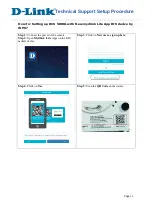
724-746-5500 | blackbox.com
Page 164
724-746-5500 | blackbox.com
Chapter 11: Deployment Examples CLI
Step 3: Configure the wireless clients.
Define the “employee” SSID on all the wireless clients. Specify WPA-PSK for network authentication, AES or TKIP for data
encryption, and the preshared key N38bu7Adr0n3.
Step 4: Position and power on the SmartPath AP.
1. Place the SmartPath AP within range of the wireless clients and, optionally, mount it as explained in the mounting section in
the chapter about the SmartPath AP model that you are using.
2. Connect an Ethernet cable from the PoE In port to the network switch.
3. If you have powered off the SmartPath AP, power it back on by reconnecting it to a power source.
When you power on the SmartPath AP, the mgt0 interface, which connects to the wired network through the eth0 port, auto-
matically receives its IP address through DHCP.
Step 5: Check that clients can form associations and access the network.
1. To check that a client can associate with the SmartPath AP and access the network, open a wireless client application and con-
nect to the “employee” SSID. Then contact a network resource, such as a web server.
2. Log in to the SmartPath AP CLI, and check that you can see the MAC address of the associated client and an indication that
the correct SSID is in use by entering the following command:
show ssid employee station
Check that the MAC address
in the table matches that of
the wireless client .
Check that the authentication and
encryption modes match those in
the SSID security protocol suite.
show ssid employee station
Chan=channel number; Pow=Power in dbm;
A-Mode=Authentication mode; Cipher=Encryption mode;
A-Time=Associated time; Auth=Authenticated;
UPID=User profile Identifier; Phymode=Physical mode;
Mac Addr
IP Addr
Chan Rate Pow A-Mode
Cipher A-Time
VLAN Auth UPID Phymode
-------------- --------- ---- ---- ---- -------- ------- -------- ---- ---- ---- -------
0016:cf8c:57bc 10.1.1.35 11
54M -38 wpa2-psk aes ccm 00:00:56 1
Yes 0
11g
Figure 11-2. Show SSID employee station.
NOTE: You can also enter the following commands to check the association status of a wireless client: show auth, show roaming
cache, and show roaming cache mac <mac_addr>.
The setup of a single SmartPath AP is complete. Wireless clients can now associate with the SmartPath AP using SSID “employee”
and access the network.
















































